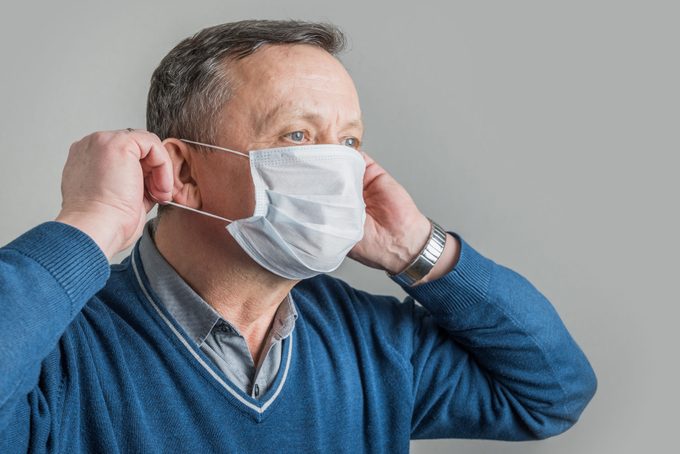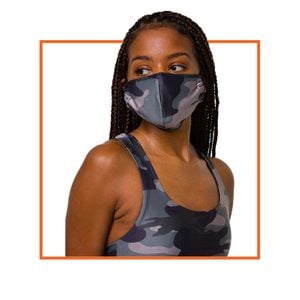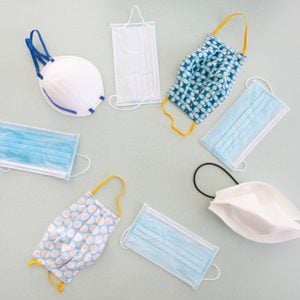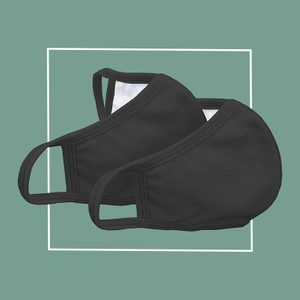Are 2 Face Masks Better Than 1 for Covid-19 Protection?
Updated: Mar. 19, 2021
Wearing a face mask can prevent the spread of Covid-19, but can two masks offer more protection? Double-masking may help, but here's what experts say about how to do it correctly.
Nearly a year into the coronavirus pandemic in the United States, it’s safe to say that—despite some early uncertainty about the best ways to prevent Covid-19—face masks are important and you should wear them.
Research clearly shows that masks are effective in preventing transmission of Covid-19 through droplets sprayed from the nose and mouth, according to the Centers for Disease Control and Prevention (CDC).
As a result, masks are required in most public indoor spaces in many states and—as of recently—on federal property. But we are still learning more about face masks, including a recent suggestion that people should double mask.
The double mask is being recommended to add an extra layer of protection against new variants of coronavirus circulating in the population that spread much more easily than those in the past. (Here’s how dangerous the new coronavirus mutations are thought to be.)
“With the new variants and their easier transmissibility there has never been a more important time to examine the effectiveness of the masks we are using,” says Beth Oller, MD, a family physician in Stockton, Kansas.
Anthony Fauci, MD, director of the National Institute of Allergy and Infectious Diseases and chief medical advisor to President Joe Biden, recently said that wearing two masks “just makes common sense.”
So, you may be wondering: Should you be wearing two masks instead of one? Here’s what you need to know.
Any mask is better than no mask
It’s clear that any mask is better than no mask. However, some are better than others. Medical-grade masks—this would include N95 masks, which filter out 95 percent of airborne particles like bacteria and viruses—are better than cloth masks, says Jay W. Lee, MD, a family physician in Orange County, California.
Medical-grade masks are now more readily available from retailers such as Amazon than they were at the beginning of the pandemic. There are other types of N95-like masks, like the KN95 (manufactured in China) and the KF94 (manufactured in Korea) that also filter out 94 to 95 percent of particles but don’t necessarily meet the same manufacturing standards as those in the United States.
(N95 vs. KN95 vs. NF94 face masks: learn the differences.)
The CDC still maintains that wearing an N95 mask isn’t necessary if you’re not working in a medical setting—especially if they’re in short supply in your area, says Soma Mandal, MD, a board-certified internist at Summit Medical Group in Berkeley Heights, New Jersey. Besides, they can be uncomfortable and difficult to wear for long periods of time, says Dr. Oller, who wears N95 masks for hours at a time to care for patients.
Adding a surgical mask over an N95 mask is thought to extend the life of an N95. It also makes sense to layer if the N95 has a valve—which allows the user to exhale unfiltered air—so that you protect other people, says Dr. Mandal. However, double masking may be more helpful for people wearing cloth masks.
(Can copper face masks offer extra protection? Here’s what the science says.)

What’s the correct way to wear a mask?
The most important factor to consider with mask-wearing is the fit of your mask to ensure it’s covering your face accordingly, says Dr. Mandal. “As a practicing physician who sees and treats Covid-19 patients, I’ve seen patients who mask incorrectly,” she says.
For instance, the mask slips down as the patient is talking; there are gaps around the edges of the mask; or the bridge of the nose on a cloth mask is lacking a proper seal. “If masks are worn in this way, this can cause unfiltered air to escape both in and out of the mask, putting the wearer at risk, as well as those around them,” she says.
Additionally, make sure the mask fits, Dr. Oller says. It should be comfortable. But it should also be snug so that it covers your nose and mouth, and fits securely under your chin.
“Non-medical masks come in different layer options,” adds Dr. Oller. “Two layers is a minimum, but three layers is better. And adjustable nose pieces help with a snug fit. If you get one that doesn’t fit right, pick a different one. Any mask that slips to the point where you are having to touch it a lot to adjust it is not the right mask.”
A mask with three layers—two layers plus a filter in between, preferably of a material called polypropylene—is considered the best option. A do-it-yourself filter made of a HEPA filter—like those found in vacuum cleaners—would also provide added protection, as do PM 2.5 filters, which are disposable inserts.
Tightly woven cotton is a good choice of mask material.
“When it comes to a reusable fabric mask, a tight-weave 100 percent cotton is the best option, as cotton masks have been shown to be better at filtration than synthetic masks,” says Dr. Mandal. Not only is the material important, but it’s also crucial to make sure that reusable masks get cleaned in hot soapy water and are completely dry before they are used again, she says.
Disposable surgical masks are also very effective and are now more readily available to the general public, says Dr. Mandal. Many surgical masks are made out of paper, but some are made of polypropylene.
(Avoid making these face mask mistakes.)
Are two masks really better than one?
According to Dr. Oller, layering two less specialized masks on top of each other can help to improve air filtration while wearing them. So if you can tolerate two masks, she recommends wearing a surgical mask as your base layer with a snug cloth mask over it.
“Wearing a surgical mask with a cloth mask over the top is also an excellent way to decrease the likelihood of Covid transmission,” she says. But “if a person finds this uncomfortable, hot, or difficult to breathe in, it could make it less likely for them to wear it consistently and correctly.” Comfort is key, she adds. “The more uncomfortable or difficult to breathe in a mask is, the less likely someone will keep it on.”
It makes sense to wear two masks (or multiple layers) in places like supermarkets or in other potentially crowded areas where people may not be able to social distance by six feet, Dr. Mandal says. “If you need to come into a medical facility, especially an emergency room or urgent care for non-Covid reasons, then wearing two masks or multiple layers is strongly recommended.”
(Want more warmth from your mask? These the best cold-weather face masks for coronavirus.)
When is it okay to not wear a mask?
If you’re exercising outdoors and maintaining a physical distance of at least six feet from everyone else, it is less risky to go without a mask, Dr. Oller says. Same goes if you are only in the presence of members of your household or your carefully chosen pod. (Check out the best air purifiers for viruses for your home.)
“We must realize however that there is always a chance that someone you are around, even in your home, is carrying Covid-19,” she says. “The name of the game is being as careful as possible. And that means always wearing a face covering if you are around people that are outside your household or pod.” (These are the best social distancing sports and workouts.)
The bottom line
Ultimately, experts want to emphasize that wearing more masks (two or more at a time) does not mean more protection if you’re not wearing them properly or adhering to the other safety protocols.
“Aside from wearing the highest-grade mask you are able to, it’s also important to maintain a physical distance of at least six feet from others,” Dr. Lee says. “Avoid indoor gatherings with people who are not part of your household, wash your hands frequently, and get vaccinated as soon as you are able.”
The key is to mask up effectively, Dr. Oller adds. If wearing two masks means you are constantly adjusting one or both of them because they’re uncomfortable, or because wearing two makes it harder to breathe, then it’s not as effective.
“If someone will consistently and correctly wear a single mask, then I’m happy,” Dr. Oller says. “And if it is a mask made from several layers, all the better.”
Next, find out if face shields stop coronavirus.



